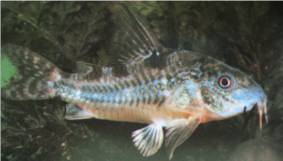Peppered Corydoras
Genus name: Corydoras Paleatus
Also known as: Peppered Cory, Peppered Cat, Salt and Pepper Cory
Distribution: South America: southeastern Brazil and La Plata Basin
Length: up to 2.8″ (7cm)
Minimum Tank Length: 18″ (45cm)
Water Temperature: 66-79F (19-26C)
Diet: Worms, crustaceans, insects, dried food, plant matter
Water: not critical, but not too acidic
Breeding: Egg Layers
The Peppered Corydoras is a tall-bodied catfish with two pairs of rather short barbels. The lateral armour of the Peppered Corydoras has 22 to 24 bony plates in the upper row, and 20 to 22 on the lower row. The upper parts are dark olive-green, or olive-brown and the underparts are pale yellow.
The Peppered Corydoras is probably the best-known and most widely kept species of Corydoras. This is not surprising, since the Peppered Corydoras is very undemanding, and it is not fussy about the water it lives in, although it appreciates a reasonable number of plants so it will have a place to hide if required. The aquarium should also have a soft bottom, preferably of sand, so that the Peppered Corydoras can burrow.
The female Peppered Corydoras is usually a little more robust, and slightly longer than the male. At spawning time, the female chooses a site of her liking, and it will probably consist of leaves of a plant, or a rock.
The male Peppered Corydoras will clasp the female, and then deposit the sperm. The female will then glue a few eggs to her chosen site, and will then sometimes quickly touch them with her mouth.
This whole process will be repeated several times, and can last for up to three hours. Often two male Peppered Corydoras will be used for each female, as one male has difficulty fertilizing all the eggs, of which there can be 200. The young Peppered Corydoras will hatch after five to six days, and will fall to the bottom once hatched.

